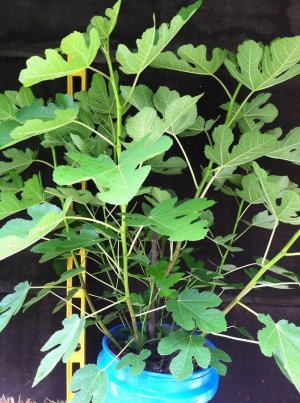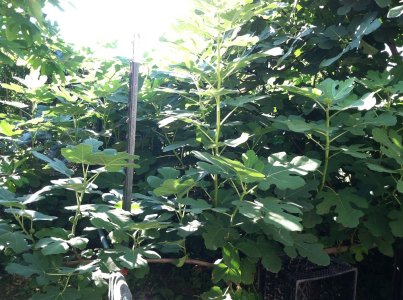When I first started cultivating figs I found very few detailed instructions for pruning and training potted fig trees other than the standard recommendation to grow as a bush form in colder zones. I found several posts by Ingevald (Byron) on the Fig Forum, the links were in Japanese so I used Google translate which provided enough info to duplicate the basic pruning techniques... The Japanese Techniques simply uses the Ficus Carica's natural growth habits to maximize fig production in a minimum space. the following procedures were trialed over the past 3 years and have proven successful in use. Step one (1) proves difficult for most growers
 , but is the most important, IMO. The pruning techniques work for in ground or potted trees and can also be used to prune existing trees.
, but is the most important, IMO. The pruning techniques work for in ground or potted trees and can also be used to prune existing trees.
Tree Form
Step 1. Establish a single, straight main trunk for the uninterrupted flow of nutrients to the scaffold limbs and fruiting branches. Remove all side branches and figs that form on a rooted cutting less than six months old. Prune the main trunk @ 16" when the trunk caliper is 3/4" or larger.
Step 2. The main scaffold limbs have to be spaced far enough apart vertically on the Main trunk for future increase in caliper size, which means that they need to be 2 to 3 nodes apart. Select 3 - 4 scaffold branches and train at 45 - 60 degree angles to main trunk. Prune at 24" at the beginning of the growing season to remove apical dominance and induce branching.
Step 3. The secondary scaffold branches that are selected and allowed to grow have to be separated by 8" (2 or more nodes) for branch caliper increase and for the growth of future fruiting branches, which are also spaced 8" apart. The main scaffold branches are lengthened by 16" and the apical tips are pruned to induce branching on the extensions, fruiting branches are then allowed to develop 8" apart.
Step 4. The fruiting branches are pruned back yearly to two (2) one year old buds (nodes) for the next seasons fruiting branches. Only one bud is allowed to grow into a fruiting branch, usually the less dominant, the other is removed.



Bush Form
Step 1. Establish a single, straight main trunk for the uninterrupted flow of nutrients to the scaffold limbs and fruiting branches. Remove all side branches and figs that form on a rooted cutting less than six months old. Prune the main trunk @ 6" when the trunk caliper is 3/4" or larger.
Step 2. The main scaffold limbs have to be spaced far enough apart vertically on the Main trunk for future increase in caliper size, which means that they need to be at least 1 node apart. Select 3 - 4 scaffold branches and train at 45 - 60 degree angles to main trunk. Prune at 40" at the beginning of the growing season to remove apical dominance and induce branching.
Step 3. The secondary scaffold branches that are selected and allowed to grow have to be separated by 8" (2 or more nodes) for branch caliper increase and for the growth of future fruiting branches, which are also spaced 8" apart. The main scaffold branches are lengthened by 16" and the apical tips are pruned to induce branching on the extensions, fruiting branches are then allowed to develop 8" apart.
Step 4. The fruiting branches are pruned back yearly to 2 one year old buds (nodes) for the next seasons fruiting branches. The fruiting branches are located at 8" intervals along the secondary scaffold branches. at the fruiting branches Only one bud is allowed to grow the other is removed.



Espalier Form
Step 1. Establish a single, straight main trunk for the uninterrupted flow of nutrients to the scaffold limbs and fruiting branches. Remove all side branches and figs that form on a rooted cutting less than six months old. Prune the main trunk @ 16" when the trunk caliper is 3/4" or larger.
Step 2. The selected main scaffold limbs are allowed to grow vertical until they are at the desired length or at least 6' tall. They are then lowered into the horizontal position over several days to ~ 2 weeks.
Step 3. The fruiting branches that develop are selected and allowed to grow. The fruiting branches are located at 8" intervals (alternate sides) along the main cordon (scaffold) branches. Eight inches (8") is the minimal spacing for the growth of the fruiting branches and leaf canopy
Step 4. The fruiting branches are pruned back yearly to 2 one year old buds (nodes) for the next seasons fruiting branches. The fruiting branches are located at 8" intervals along the secondary scaffold branches. at the fruiting branches Only one bud is allowed to grow the other is removed.




The tree can be renewed after several years by pruning back to the main trunk and starting over, or just air layering a large branch, and starting over. Also an additional benefit of this pruning technique is that the fruiting branches can easily be air layered or harvested for new plants or cuttings.
Additional References:
 point09acres.blogspot.com
point09acres.blogspot.com
 www.hawaiifruit.net
www.hawaiifruit.net
And here's a similar diagram for Columnar fig tree pruning...


Tree Form
Step 1. Establish a single, straight main trunk for the uninterrupted flow of nutrients to the scaffold limbs and fruiting branches. Remove all side branches and figs that form on a rooted cutting less than six months old. Prune the main trunk @ 16" when the trunk caliper is 3/4" or larger.
Step 2. The main scaffold limbs have to be spaced far enough apart vertically on the Main trunk for future increase in caliper size, which means that they need to be 2 to 3 nodes apart. Select 3 - 4 scaffold branches and train at 45 - 60 degree angles to main trunk. Prune at 24" at the beginning of the growing season to remove apical dominance and induce branching.
Step 3. The secondary scaffold branches that are selected and allowed to grow have to be separated by 8" (2 or more nodes) for branch caliper increase and for the growth of future fruiting branches, which are also spaced 8" apart. The main scaffold branches are lengthened by 16" and the apical tips are pruned to induce branching on the extensions, fruiting branches are then allowed to develop 8" apart.
Step 4. The fruiting branches are pruned back yearly to two (2) one year old buds (nodes) for the next seasons fruiting branches. Only one bud is allowed to grow into a fruiting branch, usually the less dominant, the other is removed.



Bush Form
Step 1. Establish a single, straight main trunk for the uninterrupted flow of nutrients to the scaffold limbs and fruiting branches. Remove all side branches and figs that form on a rooted cutting less than six months old. Prune the main trunk @ 6" when the trunk caliper is 3/4" or larger.
Step 2. The main scaffold limbs have to be spaced far enough apart vertically on the Main trunk for future increase in caliper size, which means that they need to be at least 1 node apart. Select 3 - 4 scaffold branches and train at 45 - 60 degree angles to main trunk. Prune at 40" at the beginning of the growing season to remove apical dominance and induce branching.
Step 3. The secondary scaffold branches that are selected and allowed to grow have to be separated by 8" (2 or more nodes) for branch caliper increase and for the growth of future fruiting branches, which are also spaced 8" apart. The main scaffold branches are lengthened by 16" and the apical tips are pruned to induce branching on the extensions, fruiting branches are then allowed to develop 8" apart.
Step 4. The fruiting branches are pruned back yearly to 2 one year old buds (nodes) for the next seasons fruiting branches. The fruiting branches are located at 8" intervals along the secondary scaffold branches. at the fruiting branches Only one bud is allowed to grow the other is removed.



Espalier Form
Step 1. Establish a single, straight main trunk for the uninterrupted flow of nutrients to the scaffold limbs and fruiting branches. Remove all side branches and figs that form on a rooted cutting less than six months old. Prune the main trunk @ 16" when the trunk caliper is 3/4" or larger.
Step 2. The selected main scaffold limbs are allowed to grow vertical until they are at the desired length or at least 6' tall. They are then lowered into the horizontal position over several days to ~ 2 weeks.
Step 3. The fruiting branches that develop are selected and allowed to grow. The fruiting branches are located at 8" intervals (alternate sides) along the main cordon (scaffold) branches. Eight inches (8") is the minimal spacing for the growth of the fruiting branches and leaf canopy
Step 4. The fruiting branches are pruned back yearly to 2 one year old buds (nodes) for the next seasons fruiting branches. The fruiting branches are located at 8" intervals along the secondary scaffold branches. at the fruiting branches Only one bud is allowed to grow the other is removed.




The tree can be renewed after several years by pruning back to the main trunk and starting over, or just air layering a large branch, and starting over. Also an additional benefit of this pruning technique is that the fruiting branches can easily be air layered or harvested for new plants or cuttings.
Additional References:
.09 Acres
Backyard Organic Vegetable and Fruit Gardening in Tidewater, Virginia
Figs: A Journey Through Time and Taste in Japan
US7818915B1 - Culture of edible figs - Google Patents
The present invention is in the area of agriculture and more specifically is directed to a method for improving the culture of the edible fig ( Ficus carica ). As currently grown in California, the fig tends to have a rather short season so that fresh fruit is available only sporadically. The...
www.google.com
And here's a similar diagram for Columnar fig tree pruning...

Last edited:

